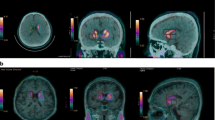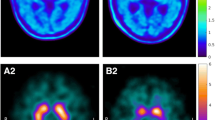Abstract
Drug-induced parkinsonism (DIP) is the common cause of parkinsonism. It is difficult to make a differentiation between DIP and Parkinson’s disease (PD) because there are no notable differences in the clinical characteristics between the two entities. In this study, we examined the relationship between the characteristics of [18F] fluorinated-N-3-fluoropropyl-2-β-carboxymethoxy-3-β-(4-iodophenyl)nortropane (FP-CIT) positron emission tomography (PET) images and clinical features in DIP patients. We retrospectively studied 76 patients with DIP who underwent [18F] FP-CIT PET. We also enrolled 16 healthy controls who underwent it. We compared the clinical characteristics between the DIP patients with normal [18F] FP-CIT PET scans and those with abnormal ones. Symmetric parkinsonism was more frequent in the patients with normal [18F] FP-CIT PET scans as compared with those with abnormal ones. Interval from drug intake to onset of parkinsonism was longer in the patients with abnormal [18F] FP-CIT PET scans as compared with those with normal ones. A semi-quantitative analysis showed that specific to non-specific binding ratios in the putamen was lower in the patients with abnormal [18F] FP-CIT PET scans as compared with those with normal ones and the age-matched control group. Our results suggest that symmetric parkinsonism was more prevalent, and the duration of drug exposure before the onset of parkinsonism was shorter in the patients with normal [18F] FP-CIT PET scans as compared with those with abnormal ones.


Similar content being viewed by others
References
Barbosa MT, Caramelli P, Maia DP et al (2006) Parkinsonism and Parkinson’s disease in the elderly: a community-based survey in Brazil (the Bambui study). Mov Disord 21:800–808
Benito-Leon J, Bermejo-Pareja F, Rodriguez J et al (2003) Prevalence of PD and other types of parkinsonism in three elderly populations of central Spain. Mov Disord 18:267–274
Shin HW, Kim MJ, Kim JS et al (2009) Levosulpiride-induced movement disorders. Mov Disord 24:2249–2253
Marti-Masso JF, Poza JJ (1998) Cinnarizine-induced parkinsonism: ten years later. Mov Disord 13:453–456
Sethi KD, Patel B, Meador KJ (1989) Metoclopramide-induced parkinsonism. South Med J 82:1581–1582
Stephen PJ, Williamson J (1984) Drug-induced parkinsonism in the elderly. Lancet 2:1082–1083
Cummings JL, Henchcliffe C, Schaier S et al (2011) The role of dopaminergic imaging in patients with symptoms of dopaminergic system neurodegeneration. Brain 134:3146–3166
Marshall V, Grosset D (2003) Role of dopamine transporter imaging in routine clinical practice. Mov Disord 18:1415–1423
Masilamoni G, Votaw J, Howell L et al (2010) (18)F-FECNT: validation as PET dopamine transporter ligand in parkinsonism. Exp Neurol 226:265–273
Davis MR, Votaw JR, Bremner JD et al (2003) Initial human PET imaging studies with the dopamine transporter ligand 18F-FECNT. J Nucl Med 44:855–861
Kim JS, Oh YS, Kim YI et al (2013) Combined use of (123)I-metaiodobenzylguanidine (MIBG) scintigraphy and dopamine transporter (DAT) positron emission tomography (PET) predicts prognosis in drug-induced Parkinsonism (DIP): a 2-year follow-up study. Arch Gerontol Geriatr 56:124–128
Lozano R, Concha MP, Montealegre A et al (2007) Effectiveness and safety of levosulpiride in the treatment of dysmotility-like functional dyspepsia. Ther Clin Risk Manag 3:149–155
Tinazzi M, Ottaviani S, Isaias IU et al (2008) [123I]FP-CIT SPET imaging in drug-induced parkinsonism. Mov Disord 23:1825–1829
Benamer TS, Patterson J, Grosset DG et al (2000) Accurate differentiation of parkinsonism and essential tremor using visual assessment of [123I]-FP-CIT SPECT imaging: the [123I]-FP-CIT study group. Mov Disord 15:503–510
Tolosa E, Coelho M, Gallardo M (2003) DAT imaging in drug-induced and psychogenic parkinsonism. Mov Disord 18(Suppl 7):S28–S33
Tarsy D (1984) Movement disorders with neuroleptic drug treatment. Psychiatr Clin North Am 7:453–471
Booij J, Habraken JB, Bergmans P et al (1998) Imaging of dopamine transporters with iodine-123-FP-CIT SPECT in healthy controls and patients with Parkinson’s disease. J Nucl Med 39:1879–1884
Varrone A, Pellecchia MT, Amboni M et al (2004) Imaging of dopaminergic dysfunction with [123I]FP-CIT SPECT in early-onset parkin disease. Neurology 63:2097–2103
Esper CD, Factor SA (2008) Failure of recognition of drug-induced parkinsonism in the elderly. Mov Disord 23(3):401–404
Hardie RJ, Lees AJ (1988) Neuroleptic-induced Parkinson’s syndrome: clinical features and results of treatment with levodopa. J Neurol Neurosurg Psychiatry 51:850–854
Goetz CG (1983) Drug-induced Parkinsonism and idiopathic Parkinson's disease. Arch Neurol 40:325–326
Garcia-Ruiz PJ, Garcia de Yebenes J, Jimenez-Jimenez FJ et al (1992) Parkinsonism associated with calcium channel blockers: a prospective follow-up study. Clin Neuropharmacol 15(1):19–26
Benvenuti F, Baroni A, Bandinelli S et al (1988) Flunarizine-induced parkinsonism in the elderly. J Clin Pharmacol 28(7):600–608
Booij J, Kemp P (2008) Dopamine transporter imaging with [(123)I]FP-CIT SPECT: potential effects of drugs. Eur J Nucl Med Mol Imaging 35(2):424–438
Nikolaus S, Antke C, Kley K et al (2010) Pretreatment with haloperidol reduces (123)I-FP-CIT binding to the dopamine transporter in the rat striatum: an in vivo imaging study with a dedicated small-animal SPECT camera. J Nucl Med 50(7):1147–1152
Mateos JJ, Lomena F, Parellada E et al (2005) Decreased striatal dopamine transporter binding assessed with [123I] FP-CIT in first-episode schizophrenic patients with and without short-term antipsychotic-induced parkinsonism. Psychopharmacology (Berl) 181(2):401–406
Chen RC, Chang SF, Su CL et al (2001) Prevalence, incidence, and mortality of PD: a door-to-door survey in Ilan county, Taiwan. Neurology 57(9):1679–1686
Li SC, Schoenberg BS, Wang CC et al (1985) A prevalence survey of Parkinson's disease and other movement disorders in the People's Republic of China. Arch Neurol 42(7):655–657
Acknowledgments
This study was supported by a Grant (2011-0416) from the Asan Institute for Life Sciences, Seoul, Korea.
Conflict of interest
The authors report no conflicts of interest.
Author information
Authors and Affiliations
Corresponding author
Rights and permissions
About this article
Cite this article
Shin, HW., Kim, J.S., Oh, M. et al. Clinical features of drug-induced parkinsonism based on [18F] FP-CIT positron emission tomography. Neurol Sci 36, 269–274 (2015). https://doi.org/10.1007/s10072-014-1945-8
Received:
Accepted:
Published:
Issue Date:
DOI: https://doi.org/10.1007/s10072-014-1945-8




